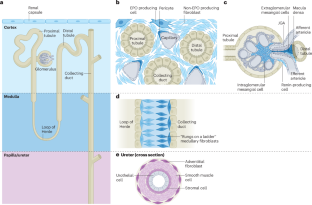发育和疾病中的肾间质
IF 39.8
1区 医学
Q1 UROLOGY & NEPHROLOGY
引用次数: 0
摘要
肾脏是人体最复杂的器官之一。它是由成千上万的有图案的上皮和内皮小管组成的,它们一起工作来维持身体的化学反应。这些不同细胞类型的精确空间整合对于器官的最佳功能至关重要。在上皮小管和内皮小管之间有一个复杂且异质性的细胞网络,统称为“基质”。越来越多的证据表明,间质介导上皮和内皮之间的交流,并在肾脏发育和成人肾脏中支持各种过程,与疾病有关。然而,基质细胞的定义远不如上皮细胞和内皮细胞明确,我们只了解其功能的一小部分,导致一些人将基质称为肾脏的“暗物质”。在这篇综述中,我们讨论了间质的发育起源,并描述了目前对其在肾上皮和内皮细胞的生长和模式以及成人器官的维持和修复中的作用的理解。最后,我们强调了仍未解决的关键问题以及回答这些问题所需的资源,以便我们能够充分了解这些神秘细胞的功能。本文章由计算机程序翻译,如有差异,请以英文原文为准。


The kidney stroma in development and disease
The kidney is one of the most complex organs in the body. It is made up of thousands of patterned epithelial and endothelial tubules that work together to maintain body chemistry. Precise spatial integration of these different cell types is essential for the organ to function optimally. A complex and heterogeneous network of cells collectively referred to as ‘stroma’ lies between the epithelial and endothelial tubules. A growing body of evidence suggests that the stroma mediates communication between the epithelia and endothelia, and functions to support a variety of processes during kidney development and in the adult kidney, with implications for disease. However, stromal cells remain far less well defined than the epithelia and endothelia, and we understand only a fraction of their functions, leading some to refer to the stroma as the ‘dark matter’ of the kidney. In this Review, we discuss the developmental origins of the stroma and describe current understanding of its roles in the growth and patterning of the renal epithelia and endothelia, and in the maintenance and repair of the adult organ. Finally, we highlight critical questions that remain unanswered and the resources that will be required to answer them so that we can fully understand the function of these enigmatic cells. Available evidence suggests that the kidney stroma mediates cell communication and supports a variety of processes during kidney development and in the adult kidney. This Review describes the developmental origins of the stroma and current understanding of its roles in the growth and patterning of renal epithelia and endothelia, and in the maintenance and repair of the adult organ.
求助全文
通过发布文献求助,成功后即可免费获取论文全文。
去求助
来源期刊

Nature Reviews Nephrology
医学-泌尿学与肾脏学
CiteScore
39.00
自引率
1.20%
发文量
127
审稿时长
6-12 weeks
期刊介绍:
Nature Reviews Nephrology aims to be the premier source of reviews and commentaries for the scientific communities it serves.
It strives to publish authoritative, accessible articles.
Articles are enhanced with clearly understandable figures, tables, and other display items.
Nature Reviews Nephrology publishes Research Highlights, News & Views, Comments, Reviews, Perspectives, and Consensus Statements.
The content is relevant to nephrologists and basic science researchers.
The broad scope of the journal ensures that the work reaches the widest possible audience.
 求助内容:
求助内容: 应助结果提醒方式:
应助结果提醒方式:


